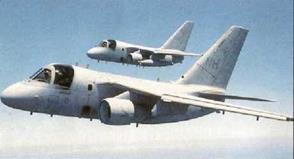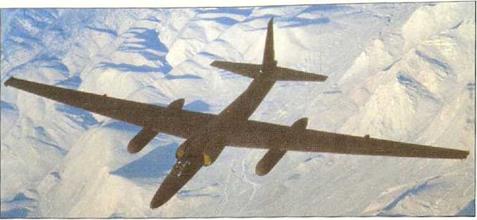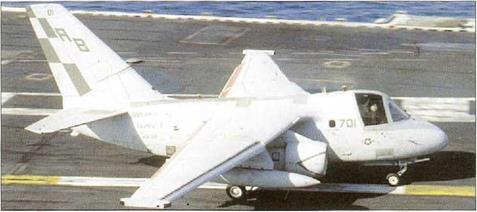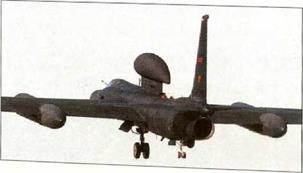Lockheed S-3 Viking Carrier-based ASW and ASuV aircraft
|
![Lockheed S-3 Viking Carrier-based ASW and ASuV aircraft Подпись: Specification: Lockheed S-3B Viking Powerplam: two 41,26-kN (9,275-lb) General flectrfc TF34-GE-2 turbarans Dimensions: wing span 20.93 m (68 ft 3 rn); length overall 1 S.26 m (53 ft 4 in) height overall 6.93 m (22 ft 9 in) Weights: empty '2038 kg (26,660 lb); (42.5Ю lb); maximum take-off 23832 kg (52,540 lb) Performance: max speed at sea level 814 kmh: (506 mph); maximum rate of climb at sea level 1280 m (4,200 It) per minute; service ceiling 10670 m 136.000 ft]; combat radius over 1751 km (1,088 miles) Armament: maximum ordnance 3175 kg (7.000 lb) with 1814 kg (4.000 lb) carried internally](/img/1244/image149_0.gif) |
 |
|
D |
eveloped to counter the new generation of Soviet navy quiet, deep-diving nuclear-powered submarines, the Lockheed S-3 Viking is the US Navy’s standard carrier-based, fixed-wing ASW aircraft. It is a conventional high-wing, twn-turbofan aircraft with four crew (pilot co-pilot, tactical coordinator and acoustic sensor operator) The first of eight service-test YS-3As made its maiden flight on 21 January 1972, and was followed by 179 production S-3A Vikings equipped with an AN/APS-116 search radar and OR-89 FUR. The heart of the ASW suite is an AN/ASQ-81 WAD sensor housed in a retractable Tailboom. The S-3A carried 60 sonobuoys in its aft fuselage and has a ventral bomb bay and wing hardpoints for bonnbs, mines torpedoes or depth charges. The S-3A entered fleet service in July 1974. Lockheed produced four US-ЗА COD aircraft which have now been retired, and a single KS-3A tanker demonstrator.
The current in-service S-3B Viking variant is the result of a 1981 upgrade programme, which added the APS-137 Inverse Synthetic Aperture Radar, the ALR-76 ESM system and the ALE-39 chaff/flare dispenser. The Viking’s anti surface warfare capability was greatly improved througn the integration of the Harpoon and Maverick missiles. About 160 S-3 As
For the future the US Navy is looking to its Common Support Aircraft requirement to replace the S-3 Viking, E-2 Hawkeye and C-2 Greyhound.
were upgraded to S-3B standard. In recent years the Viking fleet has placed less emphasis on the ASW role as the Russian naval threat receded. Vikings instead took on an increased attack and special missions role, while also acting as the de facto tanking aircraft for carrier air wings. Specialist S-3B programmes include the Outlaw Viking (over-the-horizon targeting! Beartrap Viking (ASW development), Orca Viking (ASW development) and the Grey Wolf (overland reconnaissance, command and control with a podded SAR radar)
The ES-3A Shadow was a carrier-based Elint aircraft modified from the S-3A with extensive surveillance equipment. The co-pilot’s position was replaced by a third sensor station and the bomb bays were modified to accommodate avionics. The ES-3A had a new radome, direction-finding antenna, and other equipment in a dorsal ‘shoulder’ on the fuselage, an array of seven receiving antennas on its underfuselage, an omnidirectional Elint antenna on each side of the rear fuselage, and wingtip AN/ALR 76 ESM antennas. Two squadrons operated the ES-3A from 1995 to 2000 when it was retired in favour of land-based Elint aircraft. Studies for an S-3 replacement are now being conducted under the US Navy’s Common Support Aircraft programme.
|
E |
 |
arly variants of the Lockheed U-2 had successful (if clandestine) careers as high-altitude reconnaissance platforms. However, these models were limited by the size and weight of sensors which they could carry, and so Lockheed developed the improved U-2R which first flew in August 1967. It was larger overall, offering greatly improved range/ payload, endurance and handling characteristics Twelve early-production U-2Rs served with the USAF (in Vietnam) and with the CIA.
In 1979 the production line re-opened to provide the USAF with 37 new airframes for the TR-1A tactical reconnaissance programme, using the U-2R as a platform for the ASARS-2 synthetic aperture battlefield surveillance radar, the PLSS radar location system, and all-new Sigint-gathering equipment. The batch also nc:uded two two-seat TR-1B (later TU-2R and TU-2S) trainers and one U-2RT All three two-seat trainers are identical. Finally, two ‘civilianised’ U-2Rs were built for NASA as ER-2 earth resources monitoring aircraft. In 1991 the USAF abandoned the TR-1 designation and renamed all its aircraft as U-2Rs.
All U-2R and U-2R i aircraft were re-engined with the General Electric FI01 (later redesignated F118- 101) replacing the original J75 engine, to become the U-2S and the U-2ST, respectively. The new engine had a dramatic effect on performance and operating costs. Flight tests began in 1991 and the aircraft were redelivered between 1994 and 1998.
The chief identifying feature of the U-2R/U-2S are the ‘super pods’fitted to the inboard wing. These large pods carry a range ofSigint systems
The U-2S most resembles a large powerea g ider. The retractable main bicycle undercarriage is aided by plug in detachable ‘pogo’ outriggers. The wingtips incorporate skids, above which are RWR$, Sensors are carried in the nose, a large ‘Q-bay‘ for cameras (behind the cockpit), smaller bays along the lower fuselage ano in two removeabie wing ‘super pods’. Sensors include Comint and Elint recorders, imaging radars, radar locators and high resolution cameras. A common mission fit combines a nose – mounted ASARS-2 radar and the Senior Glass Elint system with its substantial ‘farm’ of Sigint antennas on the rear fuselage and in the ‘super pods’. Recorded intelligence can be transmitted via datalink ю ground stations, and some aircraft can carry the Senior Span/Spur satcom antenna in a large rear-mounted teardrop radome. The U-2S has also been re-equipped with the SYERS (Senior Year Electro-optical Relay System) camera, which uses imaging technology developed for US reconna s- sance satellites. The electro-optical camera at the heart of SYERS is carried in the aircraft’s nose.
|
|
|
|













